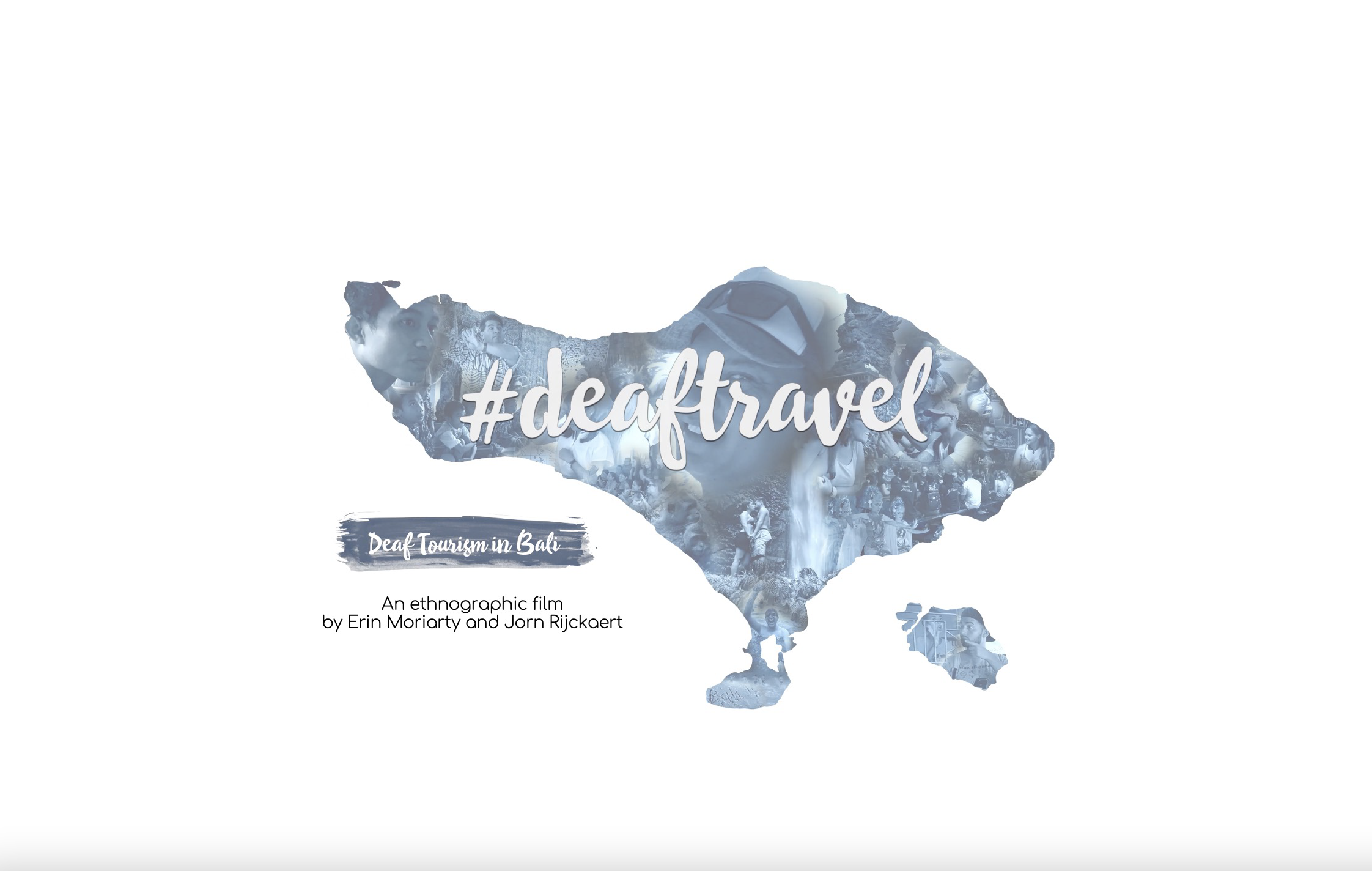#deaftravel: Deaf Tourism in Bali is an ethnographic film that explores the experiences of deaf tourists who visited Bali as solo travelers, in pairs, or in groups, in the summer of 2018. The tourists originated from Europe, the USA, and India. They joined tours guided by two deaf tour guides, Wahyu and Gio, whose quite different backgrounds inform their styles of guiding and the travel itineraries they design. The deaf tourists and guides used a range of sign languages, including International Sign. The film shows how they learn and use International Sign, BISINDO (Indonesian Sign Language), and snippets of other sign languages; and how they use gestures with hearing Indonesians. The tour guides, tourists and Balinese deaf people reflect on the ethics of tourists visiting deaf schools and a “deaf village” in north Bali, where Kata Kolok, a hyper-local sign language is used. The film ends with a reflection on various forms of mobilities within Bali and throughout the world.
The film is created by Erin Moriarty (Director and Researcher) and Jorn Rijckaert (Director, Editor, Head cameraman).
Below, film directors Erin Moriarty and Jorn Rijckaert have responded to a list of frequently asked questions to explain about this type of film, the context of the film, how it was made, and so on. This is a living document so please do send on any additional questions that we have not covered here to mobiledeaf@gmail.com!
On the bottom of this page you also will find a list of questions that can be used for further reflection or classroom discussions on the film.
1. How is ethnographic film different from a regular documentary film?
Jorn: Ethnographic films are less widely distributed than documentary films which are eg. streamed on Netflix. An ethnographic film is like a documentary film in that they are most often unscripted. Regular documentary films show a slice of reality, draw attention to an important issue or critique and can be created with the aim to use them for sensibilization or advocacy. An ethnographic documentary film is less circumscribed, and it is created in the context of academic research, to document a slice of everyday life. In this type of film we look at what people actually do, in addition to what they think or say they do.
2. Why don’t we have a narrator who flags up themes and connects the dots?
Jorn: The purpose of an ethnographic film is to show themes and the data that support these themes. The film #deaftravel allows the viewer to draw their own conclusions, without an external narrator telling people what to see or think. Of course, because #deaftravel is an edited film that is a strongly condensed version of the 6 weeks of footage that we recorded, the directors have made decisions on what they want to show. However, the directors do not take an explicit stance or argument regarding to the themes presented in the film. We want the viewers to make their own conclusions and interpretations.
3. How did you find participants? Who are they?
Erin: Initially, I had planned to return to Cambodia for my project on deaf tourism, because I had lived there for my previous research project; I knew the language, and I was familiar with the tourism landscape there. Then, the deaf-owned hostel where I had planned to stay and do participant observation closed. It seemed as if Bali was becoming the epicenter of deaf tourism, especially because of Bengkala (the deaf village that is featured in the film), and because of Wahyu’s (Bali Deaf Guide) success so I changed my fieldsite to Bali.
For the first four months of fieldwork, I developed relationships with the two deaf tourist guides working in Bali (Wahyu and Gio) to build trust and develop rapport. An initial challenge with making this film was the limited time people spend in Bali. Most participants were visiting Bali for a few days or weeks. It was difficult to predict who would be traveling in Bali while I was there. Realising I needed to be proactive in finding participants, I made a two-minute video explaining who I was, my project, and its objectives, and then I posted it on Facebook, asking people to contact me if they were interested in participating in the project. This resulted in over fifty people reposting this video on their news feeds, hundreds of referrals through the tagging of people’s names in the comments section, and personal messages via WhatsApp volunteering to participate. The sheer density and strength of the deaf network made it possible for me to interview people from a range of countries, and identify tours to observe (both group and individual).
From the start, I was very conscious of including a diversity of experiences in the film. While I interviewed a wide variety of people during the four months of research before the cameramen arrived, for the film I waslimited by who was travelling to Bali in the six weeks the cameramen were in Bali (July-August 2018). I aimed at including deaf tourists, deaf people who cater for tourists, and deaf people who experience the effects of tourism. The tourists and one of the tour guides (Gio) come from European countries, India, Australia and the USA. The Indonesian protagonists include the Indonesian guide working in Indonesia (Wahyu), deaf people in Bengkala, deaf people working in schools, and deaf community members.
The interviewees in the film are people from a wide variety of backgrounds who claim various identities, but these identities were not always disclosed or explicit in the film. We did not ask people to disclose or discuss their identities in the film as the filmmaking process was intended to be as organic and as natural as possible. The heavy representation of white deaf tourists in the film is reflective of who are mobile as tourists in Bali, and the research process itself.
4. How did the researcher decide on themes to cover in the film?
Erin: The themes were identified during fieldwork in Bali from February until June 2018 (we started filming in July), This included conversations with some members of Bali Deaf Community, visits to the deaf schools in Bali, and Bengkala, the “deaf village” in north Bali. I also accompanied tourists on one-day and multi day tours in Bali and Yogyakarta, a city on another island in Indonesia. In the more than forty interviews I conducted, I asked questions about why people visited deaf schools and the deaf village. I asked questions to draw out thoughts and feelings about languages, privilege, and power in the context of deaf mobility and tourism.
The themes in the film are based on content analysis of this data collected during the four months before the filming started. I took notes on what I observed and made notes about certain words or phrases that people often used. An example of this would be, “I wanted to see how they live,” when I asked deaf tourists why they visited deaf schools and other deaf spaces. Themes that often came up were the exchange of signs in international deaf communication, concerns about sign language imperialism and ASL spread, perceived threats to vitality of local sign languages, and “the deaf economy”.
5. How did the researcher prepare for the arrival of the camera team?
Erin: From the beginning, I had the explicit objective for this film to be an entirely deaf-led process. I planned this project with the intent to involve participants in the process of making the film. I considered providing training in filmmaking to deaf people in Bali and hiring them as cameramen; however, this was not achievable because most of the deaf people I met in Bali already had employment or other commitments. I decided to work with Jorn, an experienced deaf documentary filmmaker from Belgium who had edited a deaf ethnographic film based in India.
The forms of tourist experiences, deaf spaces, and mobilities I observed over my first four months in the field shaped decisions about equipment. Jorn and another deaf cameraman, Jente Laurijssen, arrived in Bali with specific equipment (including a drone) to fit the diverse tourist situations I had observed in the preceding months. Before Jorn arrived in Bali for six weeks of filming, I provided them with a schedule and a list of the themes that I had identified from participant observation and the interviews I conducted thus far. I also included a list of key deaf tourism sites, such as the deaf village, deaf schools in Jimbaran and Denpasar, and other locations of interest to deaf tourists such as interesting landscapes, objects, and images that I wanted filmed for later use in cutaways and for pacing during the editing process. Other examples on this list were images that establish time and place, such as a visitor’s logbook that contained pages of the names and nationalities of the tourists who had visited the two deaf schools. There are some images that, in retrospect, I wish we had filmed, such as a drone shot of the daily traffic jams on a road through rice terraces in Canggu. Often, after time away from the field and reflection, certain images take on a significance that was not apparent in the field. It was only later that I realized that immobility was a key theme, which could be illustrated with images such as traffic gridlock or waiting to board an airplane or boat.
6. What cameras did you use?
Jorn: I used an Iphone X which I bought specifically to use in Bali. I usually use a large professional camera but in Bali I needed to be flexible. Also, since people were on holiday I needed a camera that was minimally intrusive. Many tourists use smartphones all the time to make photos, so the use of a smartphone allowed me to blend in somewhat. Filming a conversation between two people was easy enough but when a conversation was going on in a group I needed the support of my camera assistant, who used a handycam, so that we could film the group from two angles.
7. How did the crew decide when and what to film?
Jorn: In the beginning of each day, Erin, myself and my camera assistant did not know what exactly we would record. It is important to arrive with the right cameras for the settings where you are filming. I used an iPhone on a handheld stabilizer, which was easy to quickly shoot what I wanted to film. Based on the themes identified by Erin I followed my gut feeling on what was important to film. I tried to anticipate on what would happen such as when people who were new to International Sign (such as Ronja, the German woman) would struggle to communicate. I could empathise with them because I went through the same before. Sometimes, a lot was going on at once and then the support from my camera assistant was crucial, such as during the Bali Deaf Community dinner. Erin also would alert me when she noted things that she thought should be recorded. So, we needed to be flexible, ready to film any time, and try to anticipate when something would happen in relation to the themes of the film. Through the weeks of filming, our focus shifted somewhat: when we reached saturation for some themes (such as communication in International Sign) we would focus more on other themes. We had a checklist of themes to go through.
8. How did the themes in the the film come together in a “red thread”?
Jorn: The “red thread” means the connection between themes in the film to make the film into a coherent whole. Figuring out the red thread with ethnographic footage is hard. This is because I don’t know what will happen. I arrived in Bali without knowing the people involved, what would happen, who the guides were, who we would film. It was all unknown. I didn’t know who we would be interviewing or how it would work out, as we were on other peoples’ schedules, so we had to fit interviews into their holiday checklist. It was all up in the air, who would agree to be interviewed, who would agree to be in the final cut, so I was free to film but it was Erin’s research. She told me what the main themes were, based on her data analysis, and we had to figure out how to connect the themes, but of course, we followed the people, places, and so on. I had to figure out how to make it a smooth narrative and edit the film based on the themes and people involved. I had to think about the structure of the film, then get deeper into the content.
So, the red thread means the “flow” of the film, which helps connect the people in the film with the themes in the research, so it is all connected and makes sense, and I also wanted viewers to feel as if they were accompanying the traveler, following them, so to say. It is like a book, all books have red threads, a structure. I know the Bali film is almost two hours long, or more accurately, one hour and 50 minutes long. I did ponder about whether it was too long but at the same time, I think the flow will draw people in so they can follow the red thread and forget the time, diving deeply into the film. When it ends, viewers will surface with a lot to mull over.
9. Why did you include scenes that show racism, xenophobia and other discriminatory behaviour?
Erin: Like the rest of the film, these scenes were not scripted, and we included them in the film to illustrate the experiences of deaf people from different backgrounds who meet in international encounters. We also show these scenes to illustrate the limitations of DEAF-SAME as a constructed ideal. The aim of showing this data is not to perpetuate further harm or to endorse these ideas and sentiments. The aim is to show that this actually happened and the ways in which the positionalities of the people involved shape their responses. For example, a participant may not have felt as if they could confront another participant in the moment because of their age, skin color, wealth, and so on. Some of the moments that we show in the film illustrate the ways in which many of us ignore or gloss over micro (or even overt) aggressions because we want to avoid conflict, are tired, or it isn’t worth the energy. We think to ourselves, “I know what that means.” These moments happen over and over in different contexts and as a deaf researcher / invested observer, I was invested in documenting how similar dynamics played out over and over in different contexts. One of the most important takeaways from this film that I hope people will appreciate is that power differences and inequality are always present, that there are different ways in which people can move or are fixed to certain places and spaces, as well as patterns as to who is looking or gazing at whom and why.
10. How did you balance your “outsider” and “insider” roles as film crew and tourists?
Jorn: The crew (myself, the camera assistant and Erin) were always looking for a balance between insider and outsider. As we were making an ethnographic film in which we did not participate ourselves, we couldn’t be fully participating in the tourist groups. At the same time, we connected with them, we were travelling together, ate together. Sometimes it was funny when the tourists wanted to make group photos and we (the crew) were in the photos too, but we wanted to use the photos in the film. Sometimes they made two group photos, one with the crew included and one without. On Instagram the tourists typically posted the photos with the crew included, but in the film we used the version with the crew not included. Sometimes we even Photoshopped a group photo to remove the crew. We were glad the people in the tourist groups understood this. Also, a day of travelling is long; we spent a lot of time in the car talking with people without doing any filming, and then when we arrived at a destination we took some distance to do the filming. So in short, we were always looking for a balance between being part of the group and being a group apart (as a crew).
11. What is the source and purpose of the social media posts that pop up in the film?
Jorn: Erin identified social media as an important theme in her data and I noticed that Instagram and Facebook were heavily used to report on tours in Bali, so I thought I wanted to do something with that in the film. The hashtag #deaftravel is used for example for networking. So when I started editing the film I wanted to do something with that. We also have different themes in the film, I had identified a red thread, but I needed to connect the different themes in some way, so that the transitions would not be too jarring. So we created a template for social media accounts. This helped creating the links between the themes, but also to show who people are, which country they are from, their interests, their motivations, and their previous trips in Bali and elsewhere. We did not use or copy people’s actual accounts, but I selected photos from people’s Facebook and Instagram accounts, as well as photos and clips they shared upon our request or which I had recorded in Bali. The texts under the photos are mostly from the tourists themselves. I shortened some of their texts and added a few words here and there to flag up themes. Usually, ethnographic film would not include elements that are partially fabricated or edited like this, so with regard to this aspect of the film, I was balancing on the line between a regular documentary film and an ethnographic film.
12. Did all people who are in the film agree to be included?
Jorn: It is critical to get permission from people before filming their realities. Being deaf helps, in terms of people feeling more comfortable. Hearing people might have a more difficult time making a film about deaf people. Deaf people often connect with each other fast, but I do quickly explain about the project. I know the camera can be intrusive and some people may feel uncomfortable being filmed so I always made it clear that if they did not want me to film something in that immediate moment, they should feel free to tell me. I am a professional and it is a part of my professional ethics to be respectful. I also told participants that even during the editing process, they would have the right to tell me they withdraw their consent. During this specific project, there were some situations where people were on the beach, in their bathing suits, and so on, so I always asked, “Are you okay with this?” This also happens with interviews, especially if people are talking about sensitive issues. We also follow up during the editing process by showing them their parts and getting their approval of the clips we decided to use in the film. Consent is an ongoing process. After selecting clips for the film, we sent each individual the particular clips they were in (only the clips they were in themselves, to protect other people’s privacy), and if or when they said no, we took it out, redid it, then showed it again to get approval. During the final cut, we also contacted people to get their permission to use their social media content and for the Instagram captions, some which we created to help make the red thread clearer. This attitude of openness helps build trust, and that is important.
Suggested questions for film discussions
- In case you have not seen other ethnographic films yet, or films about deaf people, how was this film different from other films you have seen?
- Identify the people, places, events, or aspects of the deaf experience that are the focus of this film. Describe the significance of each.
- List five things that made an impression on you and explain why. Describe an aspect of the film that led you to reconsider something or think about something in a new / different way. How did this change your thinking (or not)?
- Describe and analyse any cinematic or editing techniques used in the film to present specific scenes, images or juxtapositions that you noticed.
- If you could tell the filmmakers how to improve the film, what would you tell them? Was there anything in the film that seemed out of place, and why? Describe the changes you would make in detail and explain why.
- What do we learn about the potentials of, and problems with, international deaf mobility?
- What are some of the inequalities highlighted in the film? Think of factors such as financial capital, (im)mobility, nationality, race, language knowledge, culture, and so on. How did inequalities play out in particular scenes?
- What do we learn about the various aspects of international deaf communication, between deaf Balinese people (guides, school teachers, deaf community members, deaf village inhabitants) and deaf travellers, between hearing people in Bali and deaf travellers, and between deaf travellers among themselves (where they participate in tours in groups)?
- In what ways is “social media” a connecting thread in the film, both in the way it is edited, the themes that occur, and the places people go?
- Do you think this film will change the way you plan your travels, and the way you approach people during travels?
Do send on (mobiledeaf@gmail.com) any additional questions that you have used to discuss the film in a group, and we may add them here!
Further reading:
Moriarty, E. (2020). Filmmaking in a Linguistic Ethnography of Deaf Tourist Encounters. Sign Language Studies 20(4), 572-594. (OPEN ACCESS) https://muse.jhu.edu/article/763669
For our blogs on deaf ethnographic filmmaking, see
- https://mobiledeaf.org.uk/what-makes-a-film-a-deaf-ethnographic-film/
- https://mobiledeaf.org.uk/rodedraad/
- https://mobiledeaf.org.uk/city-lit/
- https://mobiledeaf.org.uk/mobiledeaf-at-the-filmmaking-for-fieldwork-summer-school-in-manchester/
For information on ethnographic filmmaking and definitions of what makes something ethnographic:
https://savageminds.org/tag/ethnographic-film/
Also:
Kusters, A., S. Sahasrabudhe, and A. Gopalakrishnan. 2016. A Reflexive Report on Filmmaking within a Linguistic Ethnography with Deaf and Hearing People in Mumbai. MMG Working Paper 16–04. https://www.mmg.mpg.de/61690/wp-16-04.







